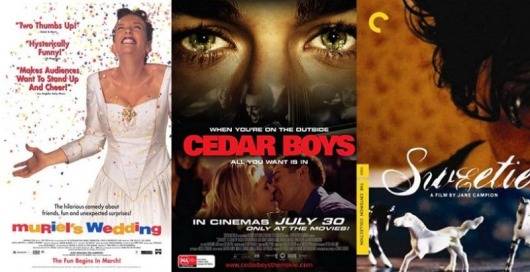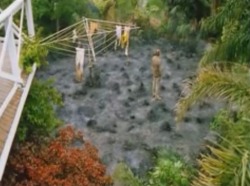Concept Analysis: Suburbia & the Australian Backyard
“Australian suburban ideology is inextricably bound up with the specific notions of the backyard, so it is no surprise that the backyards are often depicted in Australian films about suburbia”[1].
In P. J. Hogan’s Muriel’s Wedding (1994), the backyard functions within the structure of the Heslop family, and the power relations between the males and females. There is an instance in the film where Perry, as the eldest son is expected to mow the lawn, but instead of completing his chore, he is seen in the backyard playing out a fantasy scenario. “Perry is depicted actively daydreaming about being a famous footballer, a daydream which parallels Muriel’s obsessive fantasies about marriage. In this instance, he kicks a milk carton around the overgrown backyard lawn (instead of mowing it) while dodging the Hills Hoist and vociferously commentating on his ‘star’ (imaginary AFL) performance”[2]. Even at the very least level of representation, the fact that the yard is so overgrown is just an illustration of the family’s inadequacy to maintain what is considered the socially correct version of suburbia. This inadequacy is also displayed in other ways throughout the duration of the film, including the unemployment of all the kids, that Bill, the husband and father is having an affair, and the twisted way that Muriel attempts (but fails miserably) to fit in with the other girls of Porpoise Spit. The backyard again becomes the manifestation of what is wrong with both this family, and society in general when before committing suicide, Muriel’s mother sets fire to the overgrown grass, and it leaves both the family and the audience with not just an aesthetic message, but a metaphorical one as well. “This is her last act of vengeance and aggression against her suburban lifestyle and her uncaring and uncommitted husband and children. Instead of gardening in the backyard, and hence altering and improving the environment in which the family resides, a common suburban per-occupation, Betty destroys it and with it, symbolically, the Australian dream”[3]. The film effectively portrays what it is that is wicked and unjust about the stereotypical suburban expectations of society, and the ways in which this can affect individuals, families and the community at large, as well as other particularly gothic principles represented within suburban life in Australian film and television.
The 2009 film Cedar Boys (Serhat Caradee) slightly works with the vision of the backyard also, but this is more in terms of it been a safe house. It is the location where Nabil chooses to store the drugs he and Tarek have stolen, assuming it will be protected within the safety of the home. The way he hides it underneath the back veranda somewhat insinuates that maybe he thinks that the facade, the outside of the stereotypical suburban life will act as a cover up for the operation they are undertaking.
Jane Campion’s Sweetie (1989) also portrays a message about the relevance of the backyard in Australian suburbia, but in a more gothic context. We see in this film that both physical nature and character’s personalities can be representative of the different sides of suburbia, within the context of the backyard. “Sweetie is the epitome of everything that suburbia is traditionally perceived as not bring, whereas Kay represents suburbia – or nature tamed – to the point where even the presence of a tree is too much ‘raw nature’ for her to cope with”[4]. This trait of Kay’s is manifested within the backyard and being considered a film that utilises gothic concepts, the way the backyard is treated works in the same narrative structure. The most poignant scene employing of this is when Kay arrives home to see that her partner has pulled out the Hills Hoist from the paved area in the backyard and planted a baby Alder, to represent his relationship with Kay. “The Hills Hoist, of course, remains a pre-eminent icon of the Australian suburban backyard. Extracting it could be interpreted as an attempt to dismantle the Australian Dream of suburban culture – or the tamed, controlled nature represented by the Hills Hoist – and replace it with raw nature and thus freedom, untamed sexuality and disorder that the tree represents”[5].
In P. J. Hogan’s Muriel’s Wedding (1994), the backyard functions within the structure of the Heslop family, and the power relations between the males and females. There is an instance in the film where Perry, as the eldest son is expected to mow the lawn, but instead of completing his chore, he is seen in the backyard playing out a fantasy scenario. “Perry is depicted actively daydreaming about being a famous footballer, a daydream which parallels Muriel’s obsessive fantasies about marriage. In this instance, he kicks a milk carton around the overgrown backyard lawn (instead of mowing it) while dodging the Hills Hoist and vociferously commentating on his ‘star’ (imaginary AFL) performance”[2]. Even at the very least level of representation, the fact that the yard is so overgrown is just an illustration of the family’s inadequacy to maintain what is considered the socially correct version of suburbia. This inadequacy is also displayed in other ways throughout the duration of the film, including the unemployment of all the kids, that Bill, the husband and father is having an affair, and the twisted way that Muriel attempts (but fails miserably) to fit in with the other girls of Porpoise Spit. The backyard again becomes the manifestation of what is wrong with both this family, and society in general when before committing suicide, Muriel’s mother sets fire to the overgrown grass, and it leaves both the family and the audience with not just an aesthetic message, but a metaphorical one as well. “This is her last act of vengeance and aggression against her suburban lifestyle and her uncaring and uncommitted husband and children. Instead of gardening in the backyard, and hence altering and improving the environment in which the family resides, a common suburban per-occupation, Betty destroys it and with it, symbolically, the Australian dream”[3]. The film effectively portrays what it is that is wicked and unjust about the stereotypical suburban expectations of society, and the ways in which this can affect individuals, families and the community at large, as well as other particularly gothic principles represented within suburban life in Australian film and television.
The 2009 film Cedar Boys (Serhat Caradee) slightly works with the vision of the backyard also, but this is more in terms of it been a safe house. It is the location where Nabil chooses to store the drugs he and Tarek have stolen, assuming it will be protected within the safety of the home. The way he hides it underneath the back veranda somewhat insinuates that maybe he thinks that the facade, the outside of the stereotypical suburban life will act as a cover up for the operation they are undertaking.
Jane Campion’s Sweetie (1989) also portrays a message about the relevance of the backyard in Australian suburbia, but in a more gothic context. We see in this film that both physical nature and character’s personalities can be representative of the different sides of suburbia, within the context of the backyard. “Sweetie is the epitome of everything that suburbia is traditionally perceived as not bring, whereas Kay represents suburbia – or nature tamed – to the point where even the presence of a tree is too much ‘raw nature’ for her to cope with”[4]. This trait of Kay’s is manifested within the backyard and being considered a film that utilises gothic concepts, the way the backyard is treated works in the same narrative structure. The most poignant scene employing of this is when Kay arrives home to see that her partner has pulled out the Hills Hoist from the paved area in the backyard and planted a baby Alder, to represent his relationship with Kay. “The Hills Hoist, of course, remains a pre-eminent icon of the Australian suburban backyard. Extracting it could be interpreted as an attempt to dismantle the Australian Dream of suburban culture – or the tamed, controlled nature represented by the Hills Hoist – and replace it with raw nature and thus freedom, untamed sexuality and disorder that the tree represents”[5].
[1] Catherine Simpson (1999) ‘Suburban Subversions: Women’s Negotiation of Space in Contemporary Australian Cinema’, in Metro Magazine #118, 25
[2] Catherine Simpson (1999) ‘Suburban Subversions: Women’s Negotiation of Space in Contemporary Australian Cinema’, in Metro Magazine #118, 28
[3] Catherine Simpson (1999) ‘Suburban Subversions: Women’s Negotiation of Space in Contemporary Australian Cinema’, in Metro Magazine #118, 28
[4] Catherine Simpson (1999) ‘Suburban Subversions: Women’s Negotiation of Space in Contemporary Australian Cinema’, in Metro Magazine #118, 26
[5] Catherine Simpson (1999) ‘Suburban Subversions: Women’s Negotiation of Space in Contemporary Australian Cinema’, in Metro Magazine #118, 26
[2] Catherine Simpson (1999) ‘Suburban Subversions: Women’s Negotiation of Space in Contemporary Australian Cinema’, in Metro Magazine #118, 28
[3] Catherine Simpson (1999) ‘Suburban Subversions: Women’s Negotiation of Space in Contemporary Australian Cinema’, in Metro Magazine #118, 28
[4] Catherine Simpson (1999) ‘Suburban Subversions: Women’s Negotiation of Space in Contemporary Australian Cinema’, in Metro Magazine #118, 26
[5] Catherine Simpson (1999) ‘Suburban Subversions: Women’s Negotiation of Space in Contemporary Australian Cinema’, in Metro Magazine #118, 26


